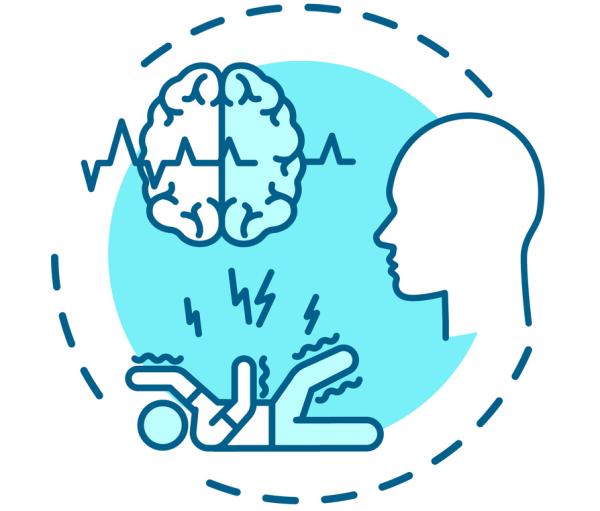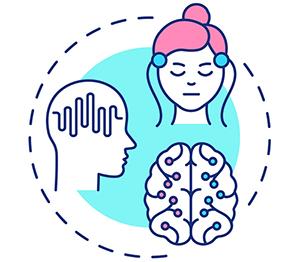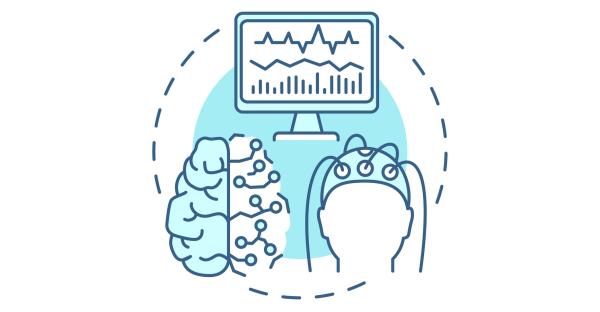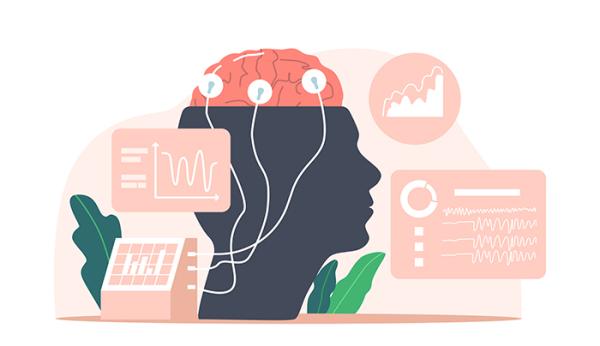Epilepsy
What is epilepsy?
Epilepsy is a group of diseases of the brain. With epilepsy, a person has had 2 or more seizures without a clear cause. The seizures may run in the person’s family or may be due to a brain injury. The brain injury could be from many causes, including severe head trauma, stroke, brain infection or brain malformation that the person is born with. The cause may also be unknown.
How common is epilepsy?
Between 0.5 and 1% of the population suffers from epilepsy. In Nova Scotia, this means that between 4500 and 9000 people may have epilepsy. Most epilepsy begins at the extremes of age (childhood and old age) but new cases can develop at any age, depending on the cause.
Is epilepsy inherited?
Some kinds of epilepsy have an inherited pattern. This means the disease may run in families. Most commonly these are forms of the generalized epilepsies that begin in childhood or the teenage years.
Although rare, some people have certain inherited diseases that have epilepsy as only one of many features of the illness. When epilepsy is the only sign of the iIIness, there is a low chance of inheritance.
Seizures
What is a seizure?
A seizure is a brief, abnormal, excessive (too much) discharge of electrical energy in the brain. A seizure may produce a noticeable change in behaviour. There are many different types of seizures. The type of seizure depends on the part of the brain where the seizure starts (seizure focus) and the way the abnormal electrical discharge spreads through the brain.
The person may have sensations such as:
- “Pins and needles"
- Smells
- Sounds
- Fear
- Depression
- Changes in sight or hearing
- Momentary muscle twitches or head nods
- Staring with loss of awareness
- Convulsive movements (spasms)
Most seizures last seconds to minutes, and rarely longer.
The time period right after a seizure, called the “postictal period”, varies depending on the length of time, strength and type of seizure. The most common symptoms that a person may have right after a seizure are:
- Confusion
- Muscle aches
- Headache
- Fatigue (tiredness)
Auras
Auras: an early warning system for seizures
An aura is a sensation, feeling or movement that is actually a “focal” seizure. Auras may consist of dizziness, an unusual feeling in the stomach, buzzing in the ear, a powerful emotion or just about any sensation at all. There may be movement of an arm or leg, hand or foot, or even the face. Many people don’t realize they have an aura until they talk about their symptoms with a doctor. Remember that an aura is really just another seizure type – one that you are aware of.
After you have a seizure, try to remember if there was anything unusual at the start (like an unexplained sensation or feeling) and write it down. Identifying an aura can be helpful. If you start to notice a pattern, you may have found an early warning system for your seizures. You may be able to take quick precautions to be safer when the seizure progresses. Also, the symptoms you have during an aura may help your doctor figure out where in your brain the seizures start.
How are seizures classified?
Seizure classification describes the type of seizures, but doesn’t tell us why you have them. Seizure classification can help determine the type of tests and treatment that will be best for you.
Seizures are classified by what part of the brain they affect. The brain is like a team of workers. Certain parts of the brain are responsible for certain jobs. For example, one part of the brain is responsible for how we see; another part is responsible for movement. Other parts of the brain control our abilities to speak, smell and taste. All parts of the brain communicate with each other over a network of brain cells called “neurons”. Neurons communicate through small electrical charges that travel along nerve pathways similar to electricity in a wire.
Classification and seizure types
Generalized seizures
A seizure is called “generalized” if there is an uncontrolled electrical discharge that affects both sides of the brain from the start. The main types of generalized seizures are tonic-clonic seizures, absence seizures, myoclonic seizures, tonic seizures and atonic seizures.
Tonic-clonic seizures
Tonic-clonic seizures (in the past called “grand mal”) start with loss of consciousness, followed by body stiffening (tonic phase), a fall if standing, and often a cry caused by air forced through contracted (tightened) vocal cords. Next, the legs and arms begin to jerk (clonic phase).Breathing may be shallow and irregular; skin may look bluish because of irregular breathing. Tonic-clonic seizures usually last 1-2 minutes.
- Other symptoms that can happen during this kind of seizure include drooling, biting of the tongue or cheek, and loss of bladder or bowel control. Consciousness returns slowly.
- The postictal (post-seizure) symptoms can include headache, confusion and fatigue lasting minutes to hours. Shortly after consciousness returns, the person will often fall asleep.
When tonic-clonic seizures repeat without full recovery between seizures, this is called status epilepticus and is a medical emergency.
When a single tonic-clonic seizure lasts 5 minutes (not including the postictal phase or recovery phase) call 911 for medical help.
Absence seizures
Absence seizures (called “petit mal” in the past) consist of short episodes of staring into space for a period of 5-30 seconds. Impairment of awareness (failure to respond) starts without warning and ends suddenly, leaving the person alert and attentive. During this kind of seizure the person may have rapid eye blinking or hand and mouth movements. A person who is not taking medication may have 50-100 absence seizures a day. The seizures may interfere with learning because during the seizure the person cannot remember what is being said or shown to them. Absence seizures typically start in childhood (4-14 years old) and may get better on their own in the late teenage years.
Myoclonic seizures
Myoclonic seizures consist of brief, shock-like jerks of a muscle or group of muscles. These seizures usually cause abnormal movements on both sides of the body at the same time. The legs are usually involved. Similar movements may happen in healthy people who do not have epilepsy. For example, as many people fall asleep, their body suddenly jerks (referred to as “somnolescent starts”).
Tonic seizures
Tonic seizures usually last less than 20 seconds. They are associated with sudden stiffening movements of the body, arms or legs, and involve both sides of the body at the same time. They happen more often during sleep.
Atonic seizures
Atonic seizures are identified by a sudden loss of muscle tone, which happens without warning. The person’s body and head drop (or droop).The seizure lasts only seconds but injury is common if the seizure happens while the person is standing because it will cause a fall.
Focal seizures
Focal seizures (called “partial seizures” in the past) are caused by an abnormal burst of electrical activity in only part of the brain. The signs and symptoms of a focal seizure depend on what part of the brain is involved during the seizure. Some focal seizures leave the person alert and able to interact with the environment.
Afterwards, the person is able to remember what happened because consciousness is not interrupted (see “aura”).The seizure may be a strange sensation (for example, a tingling feeling in 8 part of the body) or a rhythmic jerking movement of one limb, part of a limb or the face. Any of the senses may be affected (touch, smell, taste, sight or hearing).The person may have a sense of overwhelming fear or anxiety or have a strange memory that comes out of nowhere.
Focal seizures can last seconds to minutes and minor symptoms may not be noticeable to anyone but the person having the seizure.
Other focal seizures that involve a larger area of the brain lead to loss of awareness or consciousness. The seizure may start with a “warning” (see “Aura” on page 3).It all depends on where in the brain the seizure starts.
The person may become dazed and confused and not respond when spoken to. They may make repeated movements such as lip smacking, chewing or hand and body movements. Some people may speak inappropriately or look like they are doing specific tasks. The person will not remember these events after the seizure is over. A focal seizure can last 1-5 minutes and may be followed by drowsiness and confusion.
If a focal seizure spreads to both hemispheres (sides) of the brain, it can become a bilateral convulsive seizure (called “secondarily generalized tonic-clonic seizure” in the past).
How is epilepsy diagnosed?
There are a number of resources the doctor will use to determine the diagnosis of epilepsy. The patient’s medical history is the most important. A careful description of the circumstances and events before, during and after a seizure helps in determining the diagnosis. Reports from the patient and witnesses give the doctor valuable information.
Tests
There are tests that may help confirm the diagnosis of epilepsy and classify the seizures. Not all patients need all of these tests.
EEG (Electroencephalogram)
An EEG is the most specific test for confirming the diagnosis of epilepsy. It records electrical brain function (remember, epilepsy is a disorder of electrical brain function).
Electrical activity is recorded using small electrodes (flat metal disks) attached to the scalp with a sticky paste. The test is painless and harmless and takes about 1½ hours from start to finish, including 30 minutes of recording time.
People with epilepsy do not always have an EEG abnormality with a single recording. The abnormal electrical discharges are more likely to be seen after multiple or longer recordings. The patient may be asked to stay awake for most of the night before an EEG. This is because abnormal electrical activity otherwise not seen may happen during an EEG after sleep deprivation and during sleep. The EEG pattern recorded helps define or classify the type of seizures.
Video EEG telemetry
A routine EEG (even with sleep deprivation) may not give the information your doctor needs for diagnosis and treatment. The EEG may need to be recorded during an actual seizure. A seizure doesn’t often happen during a regular 30 minute recording.
To have video EEG telemetry, a person must be admitted to a special inpatient Epilepsy Monitoring Unit in the hospital. They are then monitored by EEG, a video camera and a microphone, 24 hours a day for many days or weeks. Besides helping to clarify or confirm the diagnosis of epilepsy, video EEG telemetry is critical in the preoperative evaluation of persons being considered for epilepsy surgery.
CT scan (Computerized Axial Tomography)
A CT scan lets the doctor see your brain structure. During a CT scan, an X-ray beam moves around your head, taking many pictures that are then processed by a special computer. Sometimes a dye is injected into your bloodstream to make the pictures clearer. This test, along with an MRI scan (see below), is used to try to find a cause for the epilepsy or seizures.
MRI scan (Magnetic Resonance Imaging)
An MRI scan gives very precise and lifelike pictures of your brain structure using a very large magnet, radio waves and a computer. Like a CT scan, an MRI scan is also used to try to find a cause for the epilepsy. This test takes 45-60 minutes. You must lie as still as possible in the scanner.
If you have a Vagus, Nerve Stimulator (VNS), it must be turned OFF before an MRI scan is done. Once your test is completed the VNS can be turned back on by your doctor.
Functional MRI (fMRI) is a neuroimaging procedure that measures brain function by finding small changes in blood flow. This test takes about 30 minutes and is used to try to help your doctor advise you about the safety of a surgical procedure for epilepsy. The test is most often done to identify the brain location of speech and language function and areas involved with movement of body parts.
PET scan (Positron Emission Tomography)
A PET scan is also used to help locate the part of the brain that is causing seizures. Like an EEG, it is a test of brain function. Instead of electrical waves, the PET scan shows how the brain uses oxygen or glucose (sugar).
A small amount of radioactive glucose is injected into your vein, usually in the arm. The PET scan makes a picture to show how the cells in your brain use the glucose. The part of your brain where a seizure comes from doesn’t work properly. It doesn’t use the sugar like the other parts of your brain. The doctor can see that on the picture. This test takes 30-60 minutes.
MEG scan (Magnetoencephalography)
A MEG Scan is another brain function test that measures magnetic fields. For every electrical field, including those in the brain, there is a magnetic field at right angles (perpendicular) to it. A MEG scan makes a magnetic source image. The doctor uses this image to try to find where in your brain the seizures come from. The amount of time to do this test varies. It may take as long as 1½ hours. For most of that time, you will lie or sit as still as possible.
Neuropsychology
Memory problems and other thinking and learning difficulties are common in some persons with seizures. A psychologist will evaluate your situation using neuropsychological tests and an interview.
The psychologist will ask about how epilepsy has affected your personal, social, educational and work life. They will give you paper and pencil tests of memory, attention, thinking, reasoning, motor skills, language and spatial skills. The neuropsychological evaluation takes about 5 hours and may be broken up into shorter sessions if needed.
The neuropsychological evaluation can show if speech function is controlled by the left or right side of your brain. The pattern of strengths and weaknesses shown on the test results tells us what parts of the brain might be healthy or not working properly.
The neuropsychological evaluation can also help identify epilepsy surgery candidates who might be at risk for serious memory or speech disorders if they have surgery.
For people who are being investigated for epilepsy surgery, sometimes the routine neuropsychological evaluation cannot give us the answers we need. Some people need this functional MRI (fMRI).During a special MRI, the neuropsychologist will ask you to do simple language tasks.
Etomidate Speech and Memory Test (eSAM)
A very special test called an Etomidate Speech and Memory Test (eSAM) may be needed in rare cases during the pre-surgical assessment. This is only used if there is a question about your memory that the other tests have not been able to answer. For this test, a Radiologist will place a catheter (narrow tube) in an artery going to your brain and test your blood flow. Then, a special medication (called etomidate) will be injected by an anesthetist. This drug puts half of your brain “to sleep”. The neuropsychologist will then ask you questions to test your speech and memory. Your EEG will be recorded and interpreted during this test by the epilepsy doctor.
Epilepsy surgery
Surgery to cure or treat epilepsy has been used for more than 100 years, but the past 50 years have seen even more surgeries, as scientists have developed and improved technologies.
Patients with focal (or partial) epilepsy who have had little success with drug treatment for controlling seizures may be candidates for epilepsy surgery. The goal of the surgery is to remove the part of the brain that triggers the seizures without affecting important functions, such as language, memory, movement and sensation. Other types of surgery can be helpful to stop seizures from spreading and causing loss of control or falls.
Surgery for epilepsy is usually done at very specialized centres. A great deal of cooperation from the patient is needed for the pre-operative testing used to find out whether surgery would be helpful and not harmful. As with other surgical procedures, the benefits must always be carefully weighed against the risks.
Vagal Nerve Stimulation therapy
Vagal Nerve Stimulation (VNS) is an alternative therapy for some patients when other treatments haven’t worked or when traditional epilepsy surgery is not an option. The goal of VNS is not to make the patient seizure-free, but instead to try to reduce the number of seizures and to improve quality of life. A stimulator (often called “the battery”) is surgically placed under the skin below the collarbone. A wire is threaded under the skin, connecting the stimulator to the vagus nerve on the left side of the neck.
The device is programmed to give a small electrical current to the nerve that then goes to the brain. The goal is to stop seizures from spreading once they start or to stop them from starting at all.
What do I do if someone I am with has a seizure?
Staying calm is the first and most important thing to do if you witness a seizure
Bilateral or generalized tonic-clonic (convulsive) seizures
In a convulsive (generalized tonic-clonic or “grand mal”) seizure, the person loses consciousness and falls. The body is stiff at first (tonic phase). In the clonic phase, the arms and legs jerk or twitch rhythmically. Consciousness comes back slowly. The person may bite their tongue or lose control of their bladder. Other injuries may happen, such as shoulder dislocation or injuries from falling.
- Take away objects that may cause harm. Clear the area of sharp objects.
- Don’t hold the person to keep them from moving.
- Do not put anything in the person’s mouth. It is not possible for someone to swallow their tongue.
- Turn the person on his or her side.
- Do not offer food or drink until the person is fully alert.
- Reassure the person when they are back to normal consciousness; tell them they are OK.
- Stay with the person until they are fully alert and thinking clearly.
Usually a trip to the hospital is not needed. However, you should go to the hospital if:
- the seizure lasts 5 minutes or longer (not including the recovery phase)
- you have one seizure after another
- you are pregnant
- it is your first-ever seizure
- you are injured and need medical attention.
Focal seizure with impairment of consciousness or awareness (formerly called Complex Partial Seizure)
For someone who is mumbling or making random movements, including head turning or pulling at clothes, and who appears to be out of contact or unaware of their surroundings:
- Speak calmly to the person.
- Do not restrain, but gently guide the person away from danger.
- Stay with the person until he or she is fully alert.
The seizure and post-seizure confusion may last as long as 20-30 minutes.
Absence seizure
For momentary lapses of attention (absence or “petit mal” seizures), no first aid is needed; these seizures only last a few seconds. The person may look like they are daydreaming. Since these seizures are so mild-looking, they may go undiagnosed. If you suspect someone is having absence seizures, bring this to the attention of an appropriate person, such as your health care provider.



